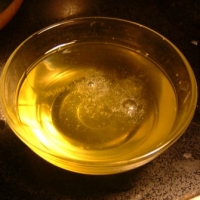How To Make Clarified Butter
From twill10 9 years agoIngredients
- http://culinaryarts.about.com shopping list
- How To Make clarified butter shopping list
- Begin With Unsalted butter shopping list
- To begin, gently melt a stick or two of unsalted butter in a heavy-bottomed saucepan over a low heat. shopping list
- Let the Milk Solids Separate shopping list
- As the butter melts, you'll see a layer of foam rising to the surface. The bubbles are the butter's water content boiling off, and the white residue is the milk proteins separating out from the butterfat and water. shopping list
- If you've ever cooked milk too long and had it curdle, it's the same thing. Curdling happens when the milk solids break away from the emulsion, either because of heat or the introduction of an acidic ingredient like lemon juice. shopping list
How to make it
- Skim the Foam and Milk Solids
- As the butter continues to simmer, use a ladle to skim the foam and milk proteins from the surface of the liquefied butter. Note the clear, golden liquid underneath the foamy residue. This is different from the technique for making ghee, in which the milk solids are allowed to settle to the bottom and turn slightly brown. That adds a nutty flavor to the ghee, which isn't bad, but it's not what we're doing here.
- Set Aside the Milk Solids
- Keep a separate bowl for the buttery, foamy milk solids you skim off ŌĆö it's fantastic on popcorn, for one thing. You can also add it to mashed potatoes, or serve over cooked vegetables or fish, or even pancakes, waffles and the like.
- Continue Skimming and Simmering
- In a few minutes you'll have skimmed off most of the milk solids, leaving just the pure, yellow butterfat.
- Another use for clarified butter is making sauces, especially butter-based emulsified sauces like Hollandaise and B├®arnaise. The water in ordinary butter can destabilize the emulsion and cause it to break. Clarified butter, with the water removed, eliminates this problem.
- Remove Clarified Butter From Heat
- Clarified butter doesn't spoil as easily as ordinary butter, so you can keep it for quite a long time, even at room temperature ŌĆö although a cool place is best, not right next to the stove. For best results, store it in an opaque container with a tight-fitting lid, since prolonged exposure to light and oxygen can cause fats to become rancid.
People Who Like This Dish 3
- whiskyb Wasaga Beach, CA
- clbacon Birmingham, AL
- jlv1023 Ansonia, Connecticut
- twill10 Cape Girardeau, MO
- Show up here?Review or Bookmark it! ✔
The Groups
- Not added to any groups yet!


Reviews & Comments 1
-
All Comments
-
Your Comments